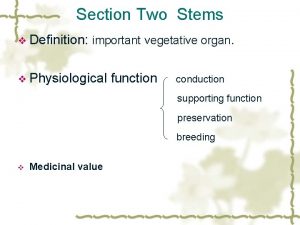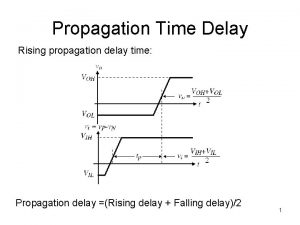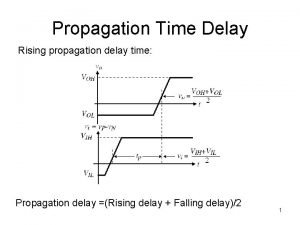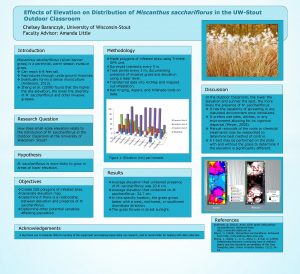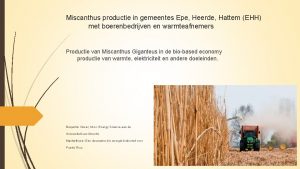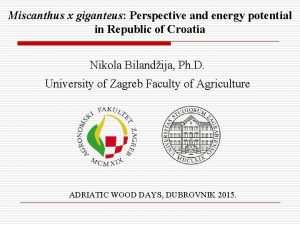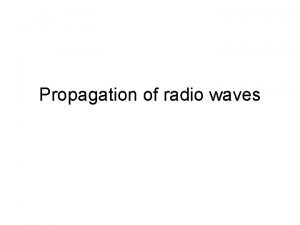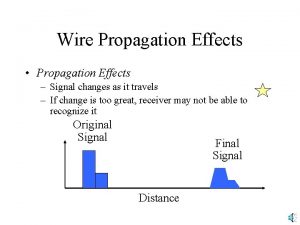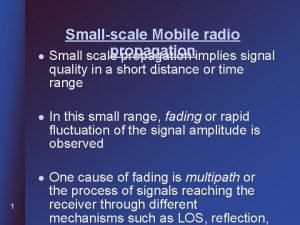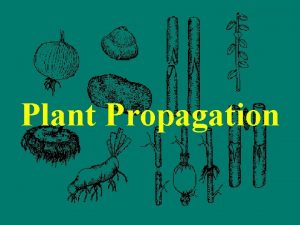NEW METHOD in the field of Miscanthus propagation






















- Slides: 22


NEW METHOD in the field of Miscanthus propagation for ethanol and power production „low-cost bio-ethanol production”

Global challenges Economic: • Decreasing energy and hydrocarbon resources • Energy sources become more and more expensive Environmental: • Speed-up of global warming and influences of it Political: • Demand of decreasing the dependence of import energy resources • Declaration of „Green-revolution”

Change of approach and construction in the energy industry • • Obligation of using renewable resources (EU, USA) Obligation of decreasing the emission (Kyoto) Support of CO 2 binding technologies New global business possibilities are opening Hydrocarbon age will be replaced by alcohol age (G. Olah, 1994 Nobel Laureate in Chemistry)

One of the most important range of producing renewable energy is growing and usage of biomass plants Among the biomass plants in temperate climates the Miscanthus giganteus plant seems to be the most efficient energy-binding one

Why Miscanthus ? • High volume of biomass yields – 15 -40 t/ha/year (DM) • Growth during 20 -25 years after planting • Low annual growing costs – No soil cultivation after 2 years – After producing N 2 -fixing plants, low/no N-fertilizer cost • Cheap, large volume of grown biomass resource • Suitable for energetic purposes in wide range • 500 -1200 €/ha support in the EU • For ethanol production is three times more efficient than corn

Energetic usage of Miscanthus 1. Supplying the energy demands of heating (90 -95%) and electric (25 -35%) power stations with direct burning. „Boiler-friendly”, low mineral-content, melting point of ashes is high: No usage problem, high heating value Demand of a 50 MW power station is : 3 -400. 000 t 15 -20. 000 ha Miscanthus 2. Cheap biomass fit – cheap ethanol raw material 6 t ethanol can be produced from 1 ha - with 20 t/ha yield 2 -3 t ethanol can be produced from corn, grown on one ha (only to compare) 3. Great volume of raw material of gas production Usable for communal (domestic, waste water treatment) and industrial (cement production) end-users as well

Miscanthus • It is usable – efficient biomass production • Annual 1 m 3 gas-equivalent is grown on 1 m 2 area (means 10. 000 m 3/ha/year), for the price of 1/5 - 1/8 gas price • Production technology is well known, can be grown widely (EU, USA) • 1 ha plantation binds 700 t CO 2 within 20 years One of the biggest global end-user of Miscanthus biomass will be the fuel industry, probably with plants supplying public traffic

Bioethanol - Miscanthus • Bioethanol market – global • E 85 = fuel with 85 % !! ethanol content • Cellulose – ethanol technologies are already cheaper than that of based on corn (under 0, 3 $ / l) • Price of the raw material is 1/5 -1/10 of that of corn • On the same area 2 -4 -times more ethanol can be produced from Miscanthus, than from corn • The electric and heat demand of production can be supplied cheapest from Miscanthus as energy source Who drops out, drops behind !! 2006 Shell-Volkswagen Miscanthus-ethanol project 2007 B. P. – 500 M $ - Miscanthus – ethanol project

• For 300 Million tons/year ethanol production • 50 Million ha Miscanthus plantation is needed /50 M ha = 35 Md t CO 2 reduced emission !!!!/ The main limits of planting are the following (EU, USA): 1. High price of planting material – high plantation cost State support: England 930£/ha, Hungary 1000 €/ha Support demand of 50 M ha - 50 Md. € (have no so much) • There is not enough propagules (planting material) For 50 M. ha: 500 Md. propagules are needed! Development of propagule-production is required!!! The solution of the problem is the development of the propagation methods as following:

Well known technologies and new method. Miscanthus giganteus is to be propagated only with clonal multiplication 1. Using Rhizomes (under-ground propagation part) 3 years (1 ha) plant can produce 20 ha There are 10. 000 ha given all over the world, that is a limitation of development !! 2. Micropropogation – biotechnological method • Theoretical unlimited propagation is possible, but with incredible high investment, energy and salery costs, it results high set price.

3. New technology: with activated stems and cuttings Propagules production utilizing plants of existing (10. 000 ha) plantations with activation of buds From 1 ha in every year 200 -400 ha new plantation can be produced, with plants are able to fix nitrogen. 4. Set / propagule prices by technologies: Taking 10. 000 pcs/ha into consideration , plantation costs of 50 Million ha by technologies: Technology price plantation cost 1. Rhizome: ≈ 0, 3 $/pc 150 Md $ / 50 M ha 2. Micropropagation: ≈0, 4 $/pc 200 Md $/ 50 M ha 3. New method (prod. cost) ≈0, 07 $/pc 35 Md $/ 50 M ha (Md =10 E 9 /Billion/, M=10 E 6, $= USD)

5. Next let us investigate, what kind of influences and results can be provided by the production of raw material technologies in event of a presumed replacement of mineral oil by ethanol, and what kind of development directions can be signed for the users: When will be given enough raw material for 300 Million t ethanol production? • with Rhizome propagation: from 2017 -2018 • with Micropropogation: from 2014 • with new method: from 2012 N-fertilizer demand of 50 M. ha plantation for 20 years: • with Rhizome propagation: 50 -100 M t • with micropropagation: 50 -100 M t • New (nitrogen-fixing plants) 0 -5 Mt

Summary: Further to the analyses, the plantation and financing of Miscanthus farms can be provided with more advantages and economic conditions by the new method, than with the known other technologies, which can be supported by the favourable influence on the environment of the nitrogen-fixing plants.

Pictures • • Activated the stems of Miscanthus Treatment in January 2008 Treatments in 2006 -2007 Plant growth promoting effect of nitrogen fixing bacteria living within the plants

Activation Activated Non-Activated stems

Activation Activated Non-Activated Cuttings (2008)



Symbioses with nitrogen-fixing and plant growth-promoting bacteria Non-treated and treated plants and the bacteria within the plant

Miscanthus yields In Europe 15 -40 t/ha/year In Illinois 27 -44 t/ha/year Illinois farm management budgets suggest much higher net margins from Miscanthus than from corn and soya bean rotations.

Presentation Developed and made by Szilard Sandor VARGA , Ph. D szilard. sandor@vipmail. hu
 Miscanthus propagation
Miscanthus propagation Bio science
Bio science Aerial stem modification examples
Aerial stem modification examples 21lwuy8i6hw -site:youtube.com
21lwuy8i6hw -site:youtube.com Individual differences in second language learning
Individual differences in second language learning Field dependent vs field independent
Field dependent vs field independent Distinguish between magnetic and nonmagnetic materials
Distinguish between magnetic and nonmagnetic materials E field h field
E field h field Data types and field properties
Data types and field properties Field dependent and field independent
Field dependent and field independent Magnetic field
Magnetic field Importance of symposium in education
Importance of symposium in education Hình ảnh bộ gõ cơ thể búng tay
Hình ảnh bộ gõ cơ thể búng tay Ng-html
Ng-html Bổ thể
Bổ thể Tỉ lệ cơ thể trẻ em
Tỉ lệ cơ thể trẻ em Voi kéo gỗ như thế nào
Voi kéo gỗ như thế nào Tư thế worm breton
Tư thế worm breton Chúa sống lại
Chúa sống lại Môn thể thao bắt đầu bằng từ chạy
Môn thể thao bắt đầu bằng từ chạy Thế nào là hệ số cao nhất
Thế nào là hệ số cao nhất Các châu lục và đại dương trên thế giới
Các châu lục và đại dương trên thế giới Công thức tính thế năng
Công thức tính thế năng


